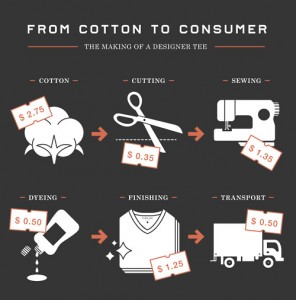John Galt Outsources Death to Bangladesh to Save Pennies on Fifty Dollar T-shirt

Graphic from retailer Everlane summarizing production costs for t-shirts that retail for fifty dollars.
In a tale of unimaginable sorrow that is made all the worse by the unconscionable greed that brought it about, at least 194 are now known to be dead in the collapse of a building in Bangladesh. But this was not just any building that collapsed, it was a building that housed multiple garment manufacturers. And in a pattern that has been repeated many times before, we see death brought about by the craven actions of the managers of the production companies while US retailers profess grief and claim no direct connection to the particular factories affected. Over time, once attention dies down a bit, those connections will become clear due to what appears to be a system designed to distance the retailers from the sweat shops via multiple subcontracting arrangements.
From today’s New York Times:
Search crews on Thursday clawed through the wreckage of a collapsed building that housed several factories making clothing for European and American consumers, with the death toll rising to at least 194 with many others still unaccounted for.
/snip/
The Bangladeshi news media reported that inspection teams had discovered cracks in the structure of Rana Plaza on Tuesday. Shops and a bank branch on the lower floors immediately closed. But the owners of the garment factories on the upper floors ordered employees to work on Wednesday, despite the safety risks.
Labor activists combed the wreckage on Wednesday afternoon and discovered labels and production records suggesting that the factories were producing garments for major European and American brands. Labels were discovered for the Spanish brand Mango, and for the low-cost British chain Primark.
Activists said the factories also had produced clothing for Walmart, the Dutch retailer C & A, Benetton and Cato Fashions, according to customs records, factory Web sites and documents discovered in the collapsed building.
The drive to save pennies on garments is directly behind this and similar tragedies:
“The front-line responsibility is the government’s, but the real power lies with Western brands and retailers, beginning with the biggest players: Walmart, H & M, Inditex, Gap and others,” said Scott Nova, executive director of Worker Rights Consortium, a labor rights organization. “The price pressure these buyers put on factories undermines any prospect that factories will undertake the costly repairs and renovations that are necessary to make these buildings safe.”
These sorts of tragedies happen with alarming regularity. Last September, at least 258 people died in a fire in a Karachi garment factory that had escaped safety inspections.
And note that although governments are cited in these tragedies for failing to provide adequate regulation and inspections, it is the tremendous pressure applied by US retailers to reduce production costs that drives many of the decisions that put workers at risk of death.
But these retailers are chasing very tiny cost reductions in the overall retail prices of garments. The graphic above is taken from a Tumblr post by retailer Everlane (they are touting their own business model of removing wholesalers, so they do have a particular point of view in promulgating the numbers). Read more →
